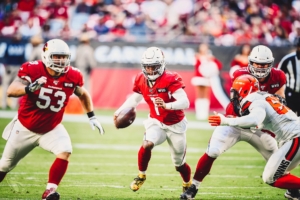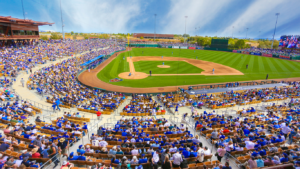If you build it, they will come.
We did. And they have.
Over the last decade, the Valley has added Jobing.com Arena, University of Phoenix Stadium, built new spring training facilities, upgraded old ones and visiting sports fans have responded by pumping billions of dollars annually into the economy. And when the Super Bowl returns to Arizona in 2015, the big winner will be the Valley, which will score an economic impact $600 million.
“If you take a look at the economic-impact studies that have been done for events such as spring training and the Fiesta Bowl and the Phoenix Open, the numbers are impressive,” says Steve Moore, president and CEO of the Greater Phoenix Convention and Visitors Bureau. “For example, the last time the Super Bowl was here, in 2008, if you added its economic impact to that of annual events like Cactus League, the Phoenix Open, the Fiesta Bowl, and the NASCAR events at PIR, you’re looking at a number approaching $2 billion.”
But economic-impact studies alone don’t tell the whole story, Moore says.
“The enormous media value of hosting Super Bowls, college bowl games, NASCAR events, and NBA and (Majore League Baseball) all-star games simply cannot be purchased,” Moore says. “These big-time events also bring in corporate executives who use the games to entertain clients, and those executives and clients often return to town with their own corporate meetings.”
Arizona tourism leaders have utilized and marketed some its the state’s best features — sunny weather that guarantees no delays, desert scenery, excellent facilities and hotels — to become a major player in the world of sports. And the impact on the industry is staggering.
“Huge and immeasurable,” says Jesse Thompson, director of sales and marketing for Hotel Valley Ho in Scottsdale. “Every traveling team spends a night in town. Every team has loyal followers who travel to see their teams. And more than just the team travel, you have sportscasters, television crews, medical teams, referees, and not to mention the hundreds of employees at these venues that service everything from security to bathroom cleaning. Also, all the ancillary travel revenues from cabs and taxis, airlines and airports, food and beverage, entertainment, and retail are huge considerations.”
Consider this:
> Cactus League baseball will have an economic impact in excess of $350 million this year; the average stay for fans will be four days; and most will spend $350 a day while they are here. “Spring training typically offers the biggest sporting-related economic boost we see every year,” says Ron Simon, general manager of Pointe Hilton Tapatio Cliffs Resort.
> The 2012 Waste Management Phoenix Open pumped $222 million into Arizona’s economy — with direct sales tax revenue estimated to be $8.2 million — and non-local attendees spent an average of $300 per day.
> When the Super Bowl rolls back into town, 85 percent of the 73,000 fans at the game will be from out of state; 65 percent of them will be key company decision-makers; another 50,000 fans will visit without tickets; and the average Super Bowl visitor will spend $2,000 while they are here.
> Glendale alone draws between 4 million and 5 million people annually to sporting events that take place in Glendale’s Sports and Entertainment District, which contribute to the city’s increased hotel occupancy and sales tax collection throughout the year.
“The Fiesta Bowl and spring training are tremendous economic engines for Glendale and the West Valley,” says Lorraine Pino, manager of the Glendale Convention & Visitors Bureau. “Both of these events bring hundreds of thousands of fans to the region. The hotel occupancy rate also reaches near capacity during spring training.”
But it’s not just high-profile athletes that drive sports tourism in Arizona. Beyond being known as a mecca for golfers, the Valley hosts high-profile events for amateur athletes that translate to big bucks for the tourism industry.
Events like Ironman Arizona and the P.F. Chang’s Rock ‘n’ Roll Marathon are huge economic drivers because they bring not only the athletes, but their families and friends out for support which drives room nights and retail dollars for the entire community,” says Tori McLaughlin, regional director of sales and marketing, West Coast for Kimpton Hotels & Restaurants, which includes both Hotel Palomar and FireSky Resort & Spa.
But beyond the beautiful golf courses, hiking trails and weather, Arizona has built its sports tourism empire by creating its own “Field of Dreams” story and epitomizing the “If you build it, they will come” strategy.
“There has been a major investment in the construction of spring training stadiums, including the development of new stadiums and enhancements to existing ones,” Simon says. “We’ve also seen great development and growth of the entertainment and shopping areas surrounding Chase Field in downtown Phoenix and Jobing.com Arena and University of Phoenix Stadium in Glendale.”
With improving infrastructure and venues, Phoenix is extremely well positioned to successfully bid for even more mega sporting events in the future, experts predict.
“Arizona’s success has created destination envy, particularly in Texas, which actually enjoys an advantage over us because they have legislation in place that allows them to provide hosting-obligation funds based on incremental visitor spending at these events,” Moore says. “In fact, both Houston and Dallas were chosen over the Valley during the last bids for the NCAA Final Four. But we’ve become a better competitor due to the metamorphosis of downtown Phoenix. We stressed this in our most recent Super Bowl bid. The fully expanded convention center, the 1,000-room Sheraton, light rail, CityScape, the new Westin and Hotel Palomar — none of these things were around in ’08, when the Super Bowl was last in Arizona. The NBA and MLB got a taste of the new downtown when they held their All-Star festivities here, and the NFL will get an even bigger taste in 2015.”




